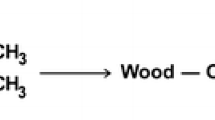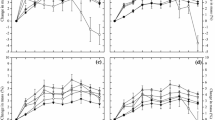Summaries
The photochemical resistance of polymers can be improved greatly by using grafted photostabilisers. This method was used here to improve the photostability of wood and the performance of clear coatings on wood. Reactive UV absorbers (UVAs), including 2-hydroxy-4 (2,3-epoxypropoxy) benzophenone (HEPBP) and some epoxy-functionalised triazine-type UVAs, were synthesised and the reaction conditions required to graft UVAs on to wood were examined. Grafting of reactive UVAs was more effective than UVA treatments without grafting or than chromium trioxide modification for restricting losses in weight and tensile strength of thin wood veneers during weathering. Grafting UVAs on to wood reduced photochemical changes at exposed wood surfaces and greatly improved the performance of clear coatings on modified veneer surfaces.
Résumé
La résistance photochimique de polymères peut être largement augmentée par l’emploi de photostabilisants greffés à la surface des bois. Cette méthode était utilisée en vue d’améliorer la photostabilité de bois et en même temps le rendement de vernis clairs sur les surfaces de bois. On a synthésisé des absorbants UV réactifs (UVAs) y compris 2-hydroxy-4(2,3-époxypropoxy) benzophénone (HEPBP) et certains UVAs du type triazine époxy-functionalisé et on a étudie les conditions nécessaires pour effectuer le greffage au bois des UVAs. Le greffage d’un UVA était plus efficace que de traitement par UVA sans greffage ou par modification avec le trioxide de chrome pour limiter les pertes en poids et de la force de tension d’un placage mince au cours d’une exposition aux intempériesl Le greffage de UVAs sur bois reduit les changements photochimiques aux surfaces de bois exposées et améliore largement le rendement de vernis clairs sur les surfaces vernis après leur modification.
Zusammenfassung
Die photochemische Bestänndigkeit der Polymeren lässt sich durch das Aufpfropfen der aufgepfropften Photostabilisatoren stark verbessert. Diese Methode wurde von die Photostabilität des Holzes und die Leistung der Klarlacken auf Holzüberflächen zu verbessern. Reacktive UV-Absorber (UDAs) mit 2-Hydroxy-4(2,3-epoxypropoxy)benzophenon (HEPBP) und einige epoxyfunktionisierte Triazosorten der UVAs wurden die Reaktions-bedingungen notwendig die UVAs aufzupfropfen synthesisiert und untersucht. Aufpfropfen den reaktiven UVAs war wirksamer als UVA-Behandlung ohne Aufpfropfen oder durch Chromtrioxid, Gewichts und Zugfestigkeitsverluste der dünnen Holzfurnieren wahrend Aussenbewitterung. UVAs aufgepfropf dem Holz stark verbessert die Leistung der Klarkacke auf modifierten Furnieroberflächen.
Similar content being viewed by others
References
Evans PD, PD Thay and KJ Schmalzl, Degradation of Wood Surfaces during Natural Weathering. Effects on Lignin and Cellulose and on the Adhesion of Acrylic Latex Primers, Wood Science and Technology,30, 411–422, 1996
Derbyshire H and ER Miller, The Photodegradation of Wood During Solar Irradation, Holz als Roh-und Werkstoff,39, 341–350, 1981
Williams RS and WC Feist, Wood Modified by Inorganic Salts: Mechanism and Properties I. Weathering Rate, Water Repellency, and Dimensional Stability of Wood Modified with Chromium (III) Nitrate Versus Chromic Acid, Wood and Fiber Science,17, (2), 184–198, 1985
Evans PD, AJ Michell and KJ Schmalzl, Studies of the Degradation and Protection of Wood Surfaces, Wood Science and Technology,26, 151–163, 1992
Williams RS, Effect of Grafted UV Stabilizers on Wood Surface Erosion and Clear Coating Performance, J. Applied Polymer Science,28, 2093–2103, 1984
Grelier S, A Castellan, S Desrousseaux, A Nourmamode and L Podgorski, Attempt to Protect Wood Colour Against UV/Visible Light by Using Antioxidants Bearing Isocyanate Groups and Grafted to the Material with Microwave, Holzforschung,51, 511–518, 1997
Kiguchi M and PD Evans, Photostabilisation of Wood Surfaces Using a Grafted Benzophenone UV Absorber, Polymer Degradation and Stability,61 (1), 33–45, 1998
Manasek Z, I Zvarai and J Luston, Synthesis of 2-hydroxy-4-(2,3-epoxypropoxy) benzophenone, J. Applied Chemistry (USSR),49, 1167–1170, 1976
Evans PD and KJ Schmalzl, A Quantitative Weathering Study of Wood Surfaces Modified by Chromium VI and Iron III Compounds, Holzforschung,43, 289–292, 1989
Kiguchi M, M Suzuki and Y Imamura, Weatherability of Exterior Wood Coatings in Japan, Conference Papers of Advances in Exterior Wood Coatings and CEN Standardisation, Brussels, Paper 12, October 1998
Rowell RM, Chemical Modification of Wood, Forest Products Abstracts,6, (12), 363–382, 1983
Author information
Authors and Affiliations
Corresponding author
Rights and permissions
About this article
Cite this article
Kiguchi, M., Evans, P., Ekstedt, J. et al. Improvement of the durability of clear coatings by grafting of UV-absorbers on to wood. Surface Coatings International Part B: Coatings Transactions 84, 263–270 (2001). https://doi.org/10.1007/BF02700407
Issue Date:
DOI: https://doi.org/10.1007/BF02700407




